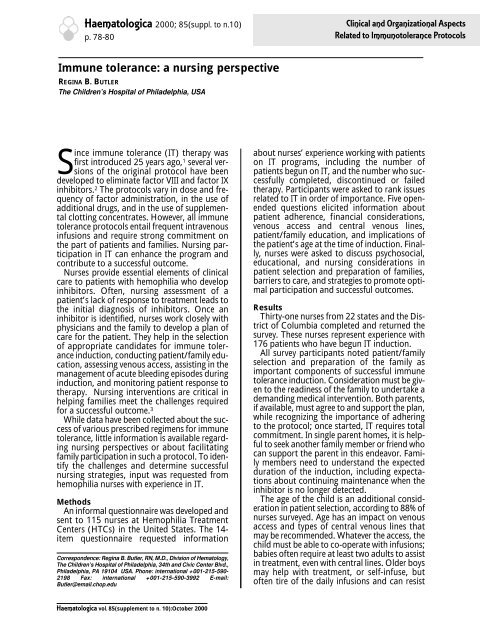Haematologica 2000;85:supplement to no. 10 - Supplements ...
Haematologica 2000;85:supplement to no. 10 - Supplements ...
Haematologica 2000;85:supplement to no. 10 - Supplements ...
Create successful ePaper yourself
Turn your PDF publications into a flip-book with our unique Google optimized e-Paper software.
<strong>Haema<strong>to</strong>logica</strong> <strong>2000</strong>; <strong>85</strong>(suppl. <strong>to</strong> n.<strong>10</strong>)<br />
p. 78-80<br />
Clinical and Organizational Aspects<br />
Related <strong>to</strong> Immu<strong>no</strong><strong>to</strong>lerance Pro<strong>to</strong>cols<br />
Immune <strong>to</strong>lerance: a nursing perspective<br />
REGINA B. BUTLER<br />
The Children’s Hospital of Philadelphia, USA<br />
Since immune <strong>to</strong>lerance (IT) therapy was<br />
first introduced 25 years ago, 1 several versions<br />
of the original pro<strong>to</strong>col have been<br />
developed <strong>to</strong> eliminate fac<strong>to</strong>r VIII and fac<strong>to</strong>r IX<br />
inhibi<strong>to</strong>rs. 2 The pro<strong>to</strong>cols vary in dose and frequency<br />
of fac<strong>to</strong>r administration, in the use of<br />
additional drugs, and in the use of <strong>supplement</strong>al<br />
clotting concentrates. However, all immune<br />
<strong>to</strong>lerance pro<strong>to</strong>cols entail frequent intrave<strong>no</strong>us<br />
infusions and require strong commitment on<br />
the part of patients and families. Nursing participation<br />
in IT can enhance the program and<br />
contribute <strong>to</strong> a successful outcome.<br />
Nurses provide essential elements of clinical<br />
care <strong>to</strong> patients with hemophilia who develop<br />
inhibi<strong>to</strong>rs. Often, nursing assessment of a<br />
patient’s lack of response <strong>to</strong> treatment leads <strong>to</strong><br />
the initial diag<strong>no</strong>sis of inhibi<strong>to</strong>rs. Once an<br />
inhibi<strong>to</strong>r is identified, nurses work closely with<br />
physicians and the family <strong>to</strong> develop a plan of<br />
care for the patient. They help in the selection<br />
of appropriate candidates for immune <strong>to</strong>lerance<br />
induction, conducting patient/family education,<br />
assessing ve<strong>no</strong>us access, assisting in the<br />
management of acute bleeding episodes during<br />
induction, and moni<strong>to</strong>ring patient response <strong>to</strong><br />
therapy. Nursing interventions are critical in<br />
helping families meet the challenges required<br />
for a successful outcome. 3<br />
While data have been collected about the success<br />
of various prescribed regimens for immune<br />
<strong>to</strong>lerance, little information is available regarding<br />
nursing perspectives or about facilitating<br />
family participation in such a pro<strong>to</strong>col. To identify<br />
the challenges and determine successful<br />
nursing strategies, input was requested from<br />
hemophilia nurses with experience in IT.<br />
Methods<br />
An informal questionnaire was developed and<br />
sent <strong>to</strong> 115 nurses at Hemophilia Treatment<br />
Centers (HTCs) in the United States. The 14-<br />
item questionnaire requested information<br />
Correspondence: Regina B. Butler, RN, M.D., Division of Hema<strong>to</strong>logy,<br />
The Children’s Hospital of Philadelphia, 34th and Civic Center Blvd.,<br />
Philadelphia, PA 19<strong>10</strong>4 USA. Phone: international +001-215-590-<br />
2198 Fax: international +001-215-590-3992 E-mail:<br />
Butler@email.chop.edu<br />
about nurses’ experience working with patients<br />
on IT programs, including the number of<br />
patients begun on IT, and the number who successfully<br />
completed, discontinued or failed<br />
therapy. Participants were asked <strong>to</strong> rank issues<br />
related <strong>to</strong> IT in order of importance. Five openended<br />
questions elicited information about<br />
patient adherence, financial considerations,<br />
ve<strong>no</strong>us access and central ve<strong>no</strong>us lines,<br />
patient/family education, and implications of<br />
the patient’s age at the time of induction. Finally,<br />
nurses were asked <strong>to</strong> discuss psychosocial,<br />
educational, and nursing considerations in<br />
patient selection and preparation of families,<br />
barriers <strong>to</strong> care, and strategies <strong>to</strong> promote optimal<br />
participation and successful outcomes.<br />
Results<br />
Thirty-one nurses from 22 states and the District<br />
of Columbia completed and returned the<br />
survey. These nurses represent experience with<br />
176 patients who have begun IT induction.<br />
All survey participants <strong>no</strong>ted patient/family<br />
selection and preparation of the family as<br />
important components of successful immune<br />
<strong>to</strong>lerance induction. Consideration must be given<br />
<strong>to</strong> the readiness of the family <strong>to</strong> undertake a<br />
demanding medical intervention. Both parents,<br />
if available, must agree <strong>to</strong> and support the plan,<br />
while recognizing the importance of adhering<br />
<strong>to</strong> the pro<strong>to</strong>col; once started, IT requires <strong>to</strong>tal<br />
commitment. In single parent homes, it is helpful<br />
<strong>to</strong> seek a<strong>no</strong>ther family member or friend who<br />
can support the parent in this endeavor. Family<br />
members need <strong>to</strong> understand the expected<br />
duration of the induction, including expectations<br />
about continuing maintenance when the<br />
inhibi<strong>to</strong>r is <strong>no</strong> longer detected.<br />
The age of the child is an additional consideration<br />
in patient selection, according <strong>to</strong> 88% of<br />
nurses surveyed. Age has an impact on ve<strong>no</strong>us<br />
access and types of central ve<strong>no</strong>us lines that<br />
may be recommended. Whatever the access, the<br />
child must be able <strong>to</strong> co-operate with infusions;<br />
babies often require at least two adults <strong>to</strong> assist<br />
in treatment, even with central lines. Older boys<br />
may help with treatment, or self-infuse, but<br />
often tire of the daily infusions and can resist<br />
<strong>Haema<strong>to</strong>logica</strong> vol. <strong>85</strong>(<strong>supplement</strong> <strong>to</strong> n. <strong>10</strong>):Oc<strong>to</strong>ber <strong>2000</strong>
















